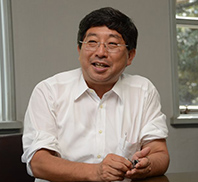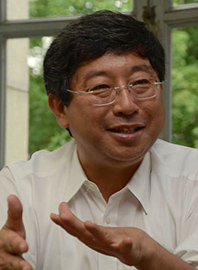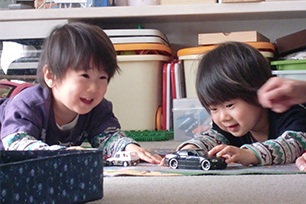Juko Ando, Professor, Faculty of Letters
What influences do heredity and environment exert on human beings?
─ Unraveling the mystery by studying twins ─
*Position titles, etc., are those at the time of publishing.
Juko Ando

B.A., Major in Education, Faculty of Letters, Keio University, 1981.
Withdrawal from the Doctoral Program with the completion of course requirements, Focus in Education, Graduate School of Human Relations, Keio University, 1986.
Research Assistant, Faculty of Letters, Keio University, 1987.
Associate Professor, Faculty of Letters, Keio University, 1993.
Professor, Faculty of Letters, Keio University, 2001.
Author of many works, such as Inconvenient Truth of Genes: All abilities are genetic.
Education also requires scientific evidence
─ Please tell us why you decided to start your twin studies.
I majored in education during college, but I always had a love for music and an interest in aesthetic education. At the time, I was deeply impressed by the Suzuki method, a method of teaching violin created by Shin'ichi Suzuki to foster musical ability in any person, toting the mantra "Talent is not born". I strongly believed that it was not one's endowed talents or their genes that were important for education. Rather, it was their environment. Moreover, the times dictated retreat from any mention of genes affecting education and human behavior due to a backlash against Nazi eugenics and the research of educational psychologist Arthur Jensen, who allegedly claimed a genetic influence over disparities in IQ scores between blacks and whites.
However, my graduate academic advisor Dr. Hiroshi Namiki taught me that the nature versus nurture argument is a fundamental educational issue. I then decided to make behavioral genetics my field of study, verifying the ways in which one's genetic makeup and environment contribute to variation in human behavior. It was also thought that the field of education at the time was unable to make a scientific case, which is why I became acutely aware of the need for hard scientific evidence.
I then thought of a method to verify the ways in which genetic makeup and environment influence human intelligence, personality, and social and psychological aspects by conducting behavioral analysis of twins raised in the same environment: that of identical twins, who share the same exact genetic material, and that of fraternal twins, who share 50% of the same genetic makeup.

─ Did your research proceed smoothly?
The twin studies required us to acquire as large a sample population as possible in order to perform reliable statistical analysis. But at first, our budget for research was virtually nonexistent, so I had no other choice but to use personal contacts to find a few twin pairs to be objects of study.
The situation changed completely in 1996 upon discovering that DRD4, a gene relating to the receptor of dopamine, a brain neurotransmitter, had a connection with novelty-seeking behavior. Genetic analysis has progressed with the development of molecular biology, at last acknowledging the importance of verifying human behavior through both genetic and environmental aspects.
Since the founding of the Keio Twin Project (KTP) in 1998, we have been able to survey approximately 8,000 twin pairs from infancy to adolescence and even into adulthood.
The importance of looking at both genes and environment

─ Specifically, what kinds of research did you conduct with your twin pairs?
Under the KTP, the primary research theme was to find out just how much genes contribute to IQ and personality. We used the "Big Five" model, which takes the following five factors into account when examining personality: extroversion, neuroticism, conscientiousness, agreeableness, and openness. We found out through our research that the heritability of each of the above was 46%, 46%, 52%, 36%, and 52% respectively. The rest was dependent on environment. In addition, we were able to scientifically prove that heredity had a large influence on both weight and IQ and that a range of human behavior was influenced by a person's genetic makeup.
─ Could you please give an example of genetic and environmental influences?
In our monozygotic (identical) and dizygotic (non-identical) twin research, we have found that even though twins have an identical genetic background, genetic factors either manifest themselves or not, depending on the individual's environment. For example, genetic disposition which causes problem behavior tends to occur more prevalently in extremely disciplinary homes and homes which do not provide consistent education. Conversely, moderately strict and consistent homes reduce the expression of these problem behavior-causing genes.
The results to an international investigation into parental discipline and twin children behavior showed that in Sweden, parents discipline their children with their own firm educational vision, and, therefore, genetic influence was minimal; in Japan, parents often adapt their parenting style to suit the child, so a tendency for genetic influence was higher.
Additionally, we were able to search out how genetic factors interact with development since we have been collecting data on the same twin pairs over a number of years now. For example, we often attribute a 6-year-old introvert's change into a 24-year-old extrovert as a factor of environment, but we may also interpret it to be the expression of a gene sometime in the growth process. We have to look at the interaction between heredity and environment.
─ What significance do these study results have?
Up until now, it was taboo to talk of genetic factors when discussing the impact of genetic and environmental factors on human behavior. However, we can no longer ignore the genetic factor as the many twin studies have provided us with evidence indicating a genetic influence over human behavior.
This does not mean, however, that we do not have to consider the environmental factor. Behavioral genetics is a science which looks theoretically and methodologically at both heredity and environment; it is a mistake to think that human behavior is decided on one of these factors alone.
Towards an education which brings out each individual's diverse abilities
─ Please tell us about the twin studies currently being done at Keio University.
Currently two institutions make up the pillars of the twin studies: one is the Keio Twin Study (KTS) that I have just discussed, which studies adolescent and adult twins; the other is the Tokyo Twin Cohort Project (ToTCoP), which began in 2004 to target infant and childhood twins.
The Keio Twin Research Center (KoTReC) was established in 2009 as an umbrella organization, and has continued its investigative research in collaboration with domestic and international researchers as the largest twin research center in Asia. Thanks to the cooperation of 2,000 adult twin pairs, 3,000 junior high and high school student twin pairs, 1,000 elementary school student twin pairs, and 2,000 preschool twin pairs and their guardians, our research has produced over 100 academic articles and presentations.

─ How do you conduct investigative research?
In addition to surveys, we have participants come into the university, and we also conduct interviews and home visits. Moreover, we have also conducted "near infrared spectroscopy (NIRS)", which checks infant brain function by measuring blood volume. Getting little kids to wear the hat-like cover when using the "NIRS" was quite the challenge.
─ Do you provide information and results to the cooperating families?
Due in part to the fact that families are becoming more and more nuclear, the reality is that parents raising twins shoulder a heavy burden. One of the roles of the Tokyo Twin Cohort Project is to relieve parents from these burdens in any way possible. The project publishes a newsletter titled "ToTCoP News" (ToTCoP Dayori) with useful information—an article on language development in twins, for example. We also hold social events for twin parents as there aren't many opportunities for parents of twins to get together and commune.
─ Please tell us about the relation of this research to real-world education.
Right now we are still researching the issue, so it may be difficult to apply it to real-world educational problems anytime soon. Still, up until now we have often said, for example, that the reason someone isn't good at mathematics is because they don't try hard enough; this is because school education has progressed without any consideration for genetic background. If we acknowledge the interaction between heredity and environment, I believe that we may be able to create an education where even if a student has a weak area, we can find their strengths and bring out each individual's diverse abilities.
*This article appeared in "Kenkyu Saizensen" (Oct. 15, 2012) of Keio University Japanese Website.
